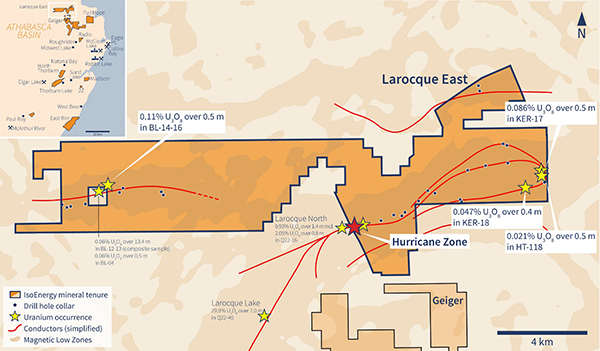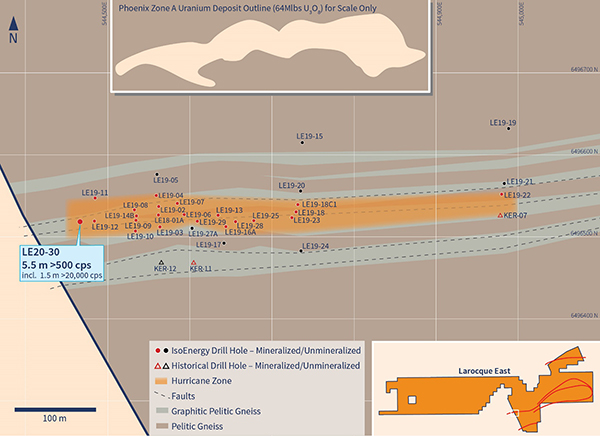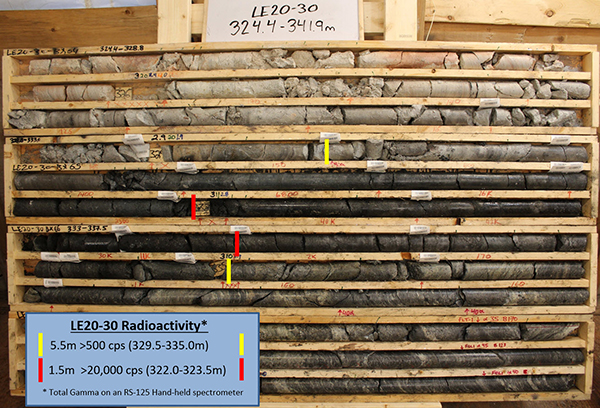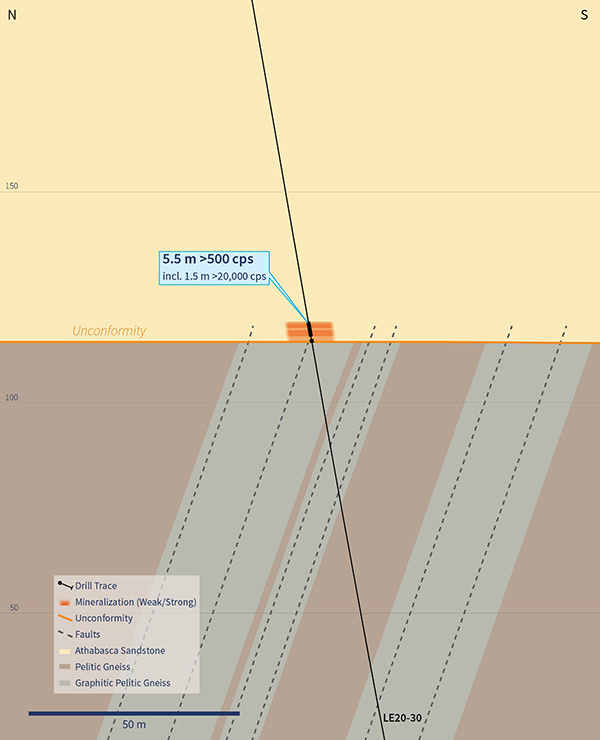IsoEnergy Intersects Strong Radioactivity at the Hurricane Uranium Zone
February 4, 2020First drill hole LE20-30 intersects 5.5m of Strong Radioactivity, extends zone 25m to the west
Vancouver, BC, February 4, 2020 – IsoEnergy Ltd. (“IsoEnergy” or the “Company”) (TSXV: ISO; OTCQX: ISENF) is pleased to report an intersection of strong radioactivity in the first drill hole of the winter program at the Hurricane zone. The Hurricane zone is a new discovery of high-grade uranium mineralization on the Company’s 100% owned Larocque East property (the “Property”) in the Eastern Athabasca Basin of Saskatchewan (Figure 1).
Highlights:
- Drill hole LE20-30 is located 25m west of the 2019 Hurricane zone footprint
- The near-vertical drill hole intersected 5.5m of strong radioactivity from 329.5-335.0m
- Mineralization is located primarily in the basal sandstone immediately above the sub-Athabasca unconformity at 334.8m
Steve Blower, Vice President of Exploration commented: “I’m pleased that we’ve been able to extend the Hurricane zone with the first drill hole of the winter program. This drill will continue to expand the zone to the west and complete several infill drill holes within the current Hurricane zone footprint. We also eagerly await the results from the second drill, which has been tasked with evaluating the potential to expand the zone to the east. That drill has now started its first hole, which is an undercut of 2019 step-out drill hole LE19-26.”
Drill Hole LE20-30 Details
Drilled to evaluate the potential to expand the Hurricane zone footprint to the west, drill hole LE20-30 was collared 25m west of 2019 drill hole LE19-12, which intersected 3.2% U3O8 and 2.1% Ni over 8.5m (Figure 2). Drill hole LE20-30 encountered strongly altered sandstone before intersecting 5.5m of strong radioactivity averaging greater than 14,000 CPS (RS-125 hand-held spectrometer) from 329.5-335.0m (Figure 3). The mineralization is located immediately above the sub-Athabasca unconformity, which was intersected at 334.8m. As the drill hole continued into the basement rocks beneath the unconformity, several strong faults were intersected, suggesting that additional targets remain to the south on this section (Figure 4). Samples have been submitted to the analytical laboratory. Chemical assay results are expected within three to four weeks.
Next Steps
The LE20-30 drill will remain on the west end of the Hurricane zone, infilling the current footprint of the zone and continuing to expand it to the west, where a 50m gap still remains between drill hole LE20-30 and the property boundary to the west.
The second drill will evaluate the potential to expand the zone to the east. This will include following up on the strong alteration, anomalous geochemistry, and elevated radioactivity in drill hole LE19-26, the only drill hole completed by the Company to date that is beyond the 500m long Hurricane zone footprint. Results from a DC-Resistivity geophysical survey completed in the summer of 2019 support the highly prospective nature of the area, which extends for several kilometres to the east. Meters and holes are expected to be split approximately equally between both drills. Further results of the program will be reported periodically throughout the winter drill season.
The Larocque East Property and the Hurricane Zone
The 100% owned Larocque East property consists of 20 mineral claims totaling 8,371 ha and is not encumbered by any royalties or other interests. Larocque East is immediately adjacent to the north end of IsoEnergy’s Geiger property and is 35 km northwest of Orano Canada’s McClean Lake uranium mine and mill.
Along with other target areas, the Property covers a 15-kilometre-long northeast extension of the Larocque Lake conductor system; a trend of graphitic metasedimentary basement rocks that is associated with significant uranium mineralization at the Hurricane zone, and in several occurrences on Cameco Corp.’s neighbouring property to the southwest of Larocque East. The Hurricane zone was discovered in July, 2018 and was followed up with a 12-hole drilling campaign in the winter of 2019 and a recently completed 17-hole summer 2019 drilling campaign. Dimensions are currently 500m along-strike, 40m wide and up to 10m thick. The zone is open for expansion along-strike and on most sections. Mineralization is polymetallic and commonly straddles the sub-Athabasca unconformity 320 m below surface. The best intersection to date is 5.4% U3O8 over 7.0m in drill hole LE19-16A. Drilling at Cameco Corp.’s Larocque Lake zone on the neighbouring property to the southwest has returned historical intersections of up to 29.9% U3O8 over 7.0 m in drill hole Q22-040. Like the nearby Geiger property, Larocque East is located adjacent to the Wollaston-Mudjatik transition zone - a major crustal suture related to most of the major uranium deposits in the eastern Athabasca Basin. Importantly, the sandstone cover on the Property is thin, ranging between 140 m and 330 m in previous drilling. In addition to the Hurricane zone discovery, four historical drill holes have intersected weak uranium mineralization at other locations on the Property to date.
Figure 1 – Larocque East Property Map

Figure 2 – Hurricane Zone Drill Hole Location Map

Figure 3 – Drill Hole LE20-30 Mineralization

Figure 4 – Vertical Cross-Section 4460E (Looking East)

Qualified Person Statement
The scientific and technical information contained in this news release was prepared by Andy Carmichael, P.Geo., IsoEnergy’s Senior Geologist, who is a “Qualified Person” (as defined in NI 43-101 – Standards of Disclosure for Mineral Projects). Mr. Carmichael has verified the data disclosed. As mineralized drill holes at the Hurricane zone are oriented very steeply (-80 to -90 degrees) into a zone of mineralization that is interpreted to be horizontal, the true thickness of the intersections is expected to be greater than or equal to 90% of the core lengths. This news release refers to properties other than those in which the Company has an interest. Mineralization on those other properties is not necessarily indicative of mineralization on the Company’s properties. For additional information regarding the Company’s Larocque East Project, including its quality assurance and quality control procedures, please see the Technical Report dated effective May 15, 2019 on the Company’s profile at www.sedar.com.
About IsoEnergy
IsoEnergy is a well-funded uranium exploration and development company with a portfolio of prospective projects in the eastern Athabasca Basin in Saskatchewan, Canada and a historical inferred mineral resource estimate at the Mountain Lake uranium deposit in Nunavut. IsoEnergy is led by a Board and Management team with a track record of success in uranium exploration, development and operations. The Company was founded and is supported by the team at its major shareholder, NexGen Energy Ltd.
Craig Parry
Chief Executive Officer
IsoEnergy Ltd.
+1 778 379 3211
cparry@isoenergy.ca
www.isoenergy.ca
Investor Relations
Kin Communications
+1 604 684 6730
iso@kincommunications.com
www.isoenergy.ca
Neither the TSX Venture Exchange nor its Regulations Services Provider (as that term is defined in the policies of the TSX Venture Exchange) accepts responsibility for the adequacy or accuracy of this release.
This news release shall not constitute an offer to sell or a solicitation of any offer to buy any securities, nor shall there be any sale of any securities in any jurisdiction in which such offer, solicitation or sale would be unlawful. The securities referenced herein have not been, nor will they be, registered under the United States Securities Act of 1933, as amended (the “U.S. Securities Act”), and such securities may not be offered or sold within the United States absent registration under the U.S. Securities Act or an applicable exemption from the registration requirements thereunder.
Forward-Looking Information
The information contained herein contains “forward-looking statements” within the meaning of the United States Private Securities Litigation Reform Act of 1995 and “forward-looking information” within the meaning of applicable Canadian securities legislation. “Forward-looking information” includes, but is not limited to, statements with respect to the activities, events or developments that the Company expects or anticipates will or may occur in the future, including, without limitation, planned exploration activities. Generally, but not always, forward-looking information and statements can be identified by the use of words such as “plans”, “expects”, “is expected”, “budget”, “scheduled”, “estimates”, “forecasts”, “intends”, “anticipates”, or “believes” or the negative connotation thereof or variations of such words and phrases or state that certain actions, events or results “may”, “could”, “would”, “might” or “will be taken”, “occur” or “be achieved” or the negative connotation thereof.
Such forward-looking information and statements are based on numerous assumptions, including among others, that the results of planned exploration activities are as anticipated, the price of uranium, the anticipated cost of planned exploration activities, that general business and economic conditions will not change in a material adverse manner, that financing will be available if and when needed and on reasonable terms, that third party contractors, equipment and supplies and governmental and other approvals required to conduct the Company’s planned exploration activities will be available on reasonable terms and in a timely manner. Although the assumptions made by the Company in providing forward-looking information or making forward-looking statements are considered reasonable by management at the time, there can be no assurance that such assumptions will prove to be accurate.
Forward-looking information and statements also involve known and unknown risks and uncertainties and other factors, which may cause actual events or results in future periods to differ materially from any projections of future events or results expressed or implied by such forward-looking information or statements, including, among others: negative operating cash flow and dependence on third party financing, uncertainty of additional financing, no known mineral reserves or resources, the limited operating history of the Company, the influence of a large shareholder, alternative sources of energy and uranium prices, aboriginal title and consultation issues, reliance on key management and other personnel, actual results of exploration activities being different than anticipated, changes in exploration programs based upon results, availability of third party contractors, availability of equipment and supplies, failure of equipment to operate as anticipated; accidents, effects of weather and other natural phenomena and other risks associated with the mineral exploration industry, environmental risks, changes in laws and regulations, community relations and delays in obtaining governmental or other approvals.
Although the Company has attempted to identify important factors that could cause actual results to differ materially from those contained in the forward-looking information or implied by forward-looking information, there may be other factors that cause results not to be as anticipated, estimated or intended. There can be no assurance that forward-looking information and statements will prove to be accurate, as actual results and future events could differ materially from those anticipated, estimated or intended. Accordingly, readers should not place undue reliance on forward-looking statements or information. The Company undertakes no obligation to update or reissue forward-looking information as a result of new information or events except as required by applicable securities laws
